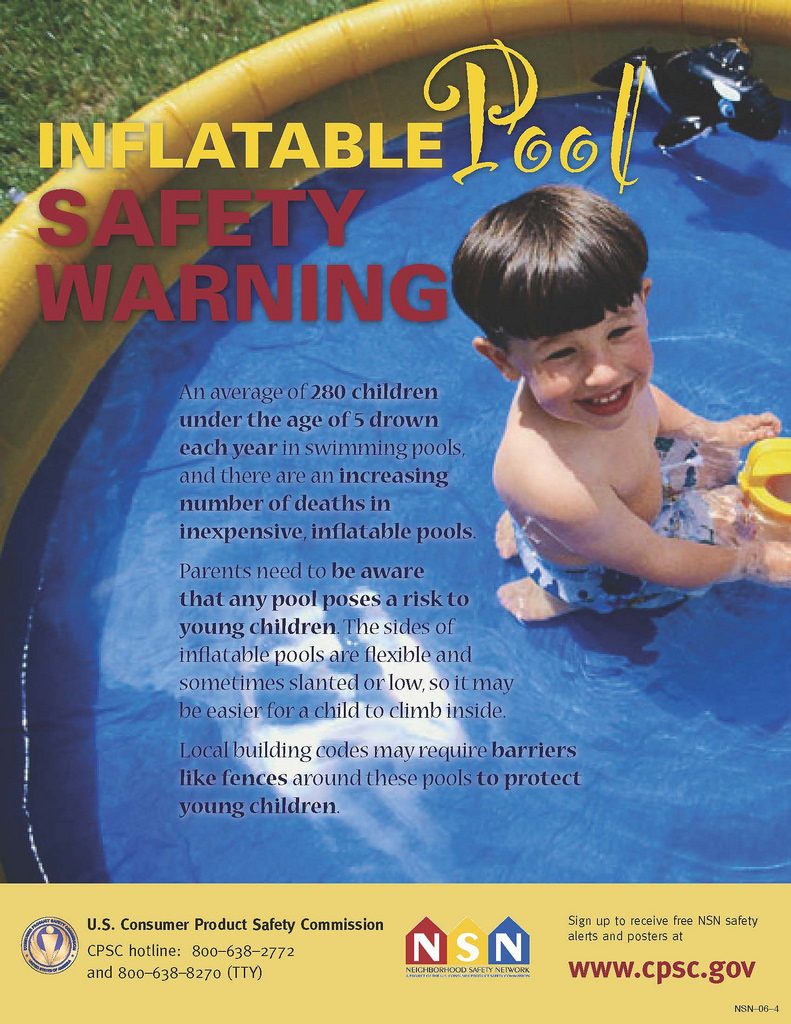Près de 90 enfants se noient chez eux chaque année. Apprendre comment prévenir ces drames.
A child can drown in as little as 2 inches of water, and it happens quickly and silently. Every one of these tragedies is preventable.
Regarder et partager cette vidéo sur YouTube
Ressources connexes
Sécurité à la piscine :
Chaque année, près de 400 enfants meurent noyés dans une piscine ou un spa. Découvrez les mesures simples que vous pouvez prendre pour sauver des vies.
Consulter la page PoolSafely.gov
CPSC Safety Alerts and Neighborhood Safety Network posters are not available to order. If you would like to use these safety publications, they are free to download and print.
Consulter toutes les publications de la CPSC relatives à la sécurité.
NSN Toolkit
Layers of Protection
In addition to close supervision, CPSC recommends layers of protection, including barriers, such as a fence with self-closing, self-latching gates, completely surrounding pools to prevent unsupervised access by young children. If the house forms a side of the barrier, use alarms on doors leading to the pool area or a power safety cover over the pool. It is important to always be prepared for an emergency by having rescue equipment and a phone near the pool. Also, parents should learn cardiopulmonary resuscitation (CPR).
Look in the Pool First
CPSC’s latest data shows that there are, on average, 379 reported pool-or-spa related fatal drownings involving children younger than 15 years old each year. Children younger than 5 years old account for about 75 percent of these drownings, more than half of which are attributed to a gap in adult supervision. Most of the victims had been missing for 5 minutes or less when they were found. Precious time is often wasted looking for missing children anywhere but in the pool. Since every second counts, always look for a missing child in the pool or spa first.
Drowning is Silent
Parents may think that if their child falls in the water, they will hear lots of splashing and screaming, and that they will be able to come to the rescue. Many times, however, children slip under the water silently. Even people near or in the pool have reported hearing nothing out of the ordinary during drowning incidents.
____________________________________________________________________
- Stop In-Home Drowning Deaths
- Children can drown quickly and silently in containers of water inside the home as well as in outdoor pools. Be aware. Don’t let it happen.
- Your Pool, Your Family's Safety (pdf) (Spanish-pdf)
- PoolSafely.gov
- CPSC’s website provides information about the Virginia Graeme Baker Pool and Spa Safety Act and how to prevent drownings and entrapments.
- Tips for Safety In and Around Water (pdf)
- This handy tip sheet provides tips for water safety in pools, spas and around the home. Print a copy and keep it in a handy location.
- Safety Barrier Guidelines for Pools (pdf)
- Provides guidelines for barriers intended to prevent drowning deaths and near-drowning deaths of children in home pools, spas and hot tubs. Guidelines cover fences, gates, audible alarms for doors with access to pools, and power safety covers.
- How to Plan for the Unexpected: Prevent Child Drownings (pdf)
- This booklet discusses how to reduce risks of child drowning deaths in residential swimming pools. Gives safety tips and provides guidance for fences and gates, pool covers, barriers, alarms, etc.
- Prevent Child In-Home Drowning Deaths (pdf)
- CPSC warns consumers about hidden drowning hazards for small children in and around the home, including bathtubs, buckets and toilets.







